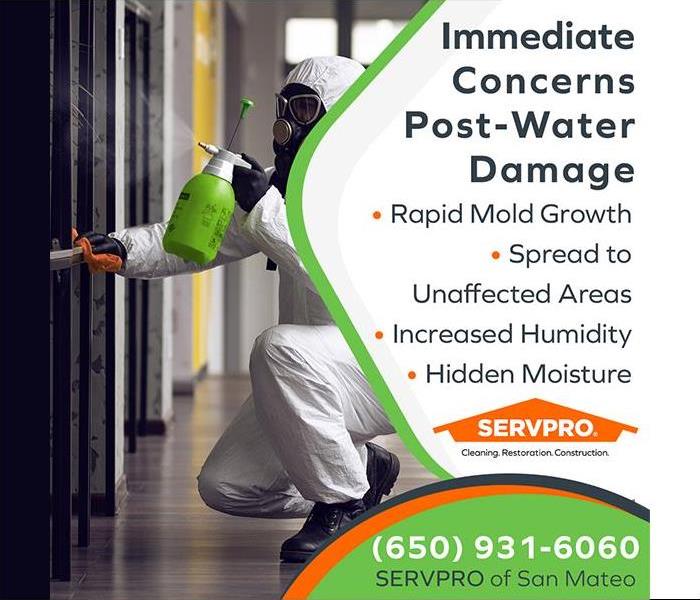Recent Mold Remediation Posts
Mold removal services in San Carlos explained
5/9/2024 (Permalink)
Mold is a serious issue in San Carlos, posing health risks and damaging property. At SERVPRO® of San Mateo, we specialize in thorough mold cleanup, quickly addressing infestations to safeguard your health and home. Our expert team is well-versed in the local conditions contributing to mold growth, using advanced techniques to eradicate mold and prevent its return. Trust us to restore your environment's safety and comfort.
Key takeaways
- Understanding the risks and origins of mold in San Carlos homes and businesses.
- Immediate actions should be taken when you detect mold.
- How SERVPRO of San Mateo employs professional mold remediation and cleanup techniques.
Why does mold occur?
Mold growth in homes and businesses is not random; it results from specific conditions that favor its development. Understanding the underlying causes of mold can help you prevent it and maintain a healthier living or working environment. In this section, we'll explore the common sources of moisture and environmental conditions that often lead to mold proliferation, providing you with the knowledge needed to combat this common issue effectively.
Sources of moisture
- Leaking pipes: Even small leaks can create damp conditions that are ideal for mold growth.
- Roof leaks: Water from roof damage can seep into attics and insulation, creating a prime habitat for mold.
- High humidity levels: Homes in humid climates or with poor ventilation can have persistent dampness.
- Condensation: Cold surfaces like windows and metal pipes can condense moisture from warm air, leading to water accumulation.
- Poor ventilation: Inadequate airflow in bathrooms and kitchens can trap moisture.
- Flooding: From external sources or internal failures, standing water is a surefire catalyst for mold.
- Appliance leaks: Dishwashers, washing machines, and refrigerators can leak, creating unnoticed moist areas.
- Damp basements and crawl spaces: These areas are inherently prone to moisture buildup and are common mold sites.
Conditions favorable for mold growth
- Warm temperatures: Mold typically thrives between 60 and 80 degrees Fahrenheit, common in many homes.
- High relative humidity: Mold growth is accelerated in environments with humidity levels above 60%.
- Poor air circulation: Stagnant air can enhance mold growth by maintaining humidity and preventing drying.
- Organic materials: Mold grows on organic materials such as wood, paper, and fabric, which absorb moisture.
- Shadows and darkness: Mold prefers less ultraviolet light and can increase in darker areas.
- Time: Mold begins to grow within 24 to 48 hours after moisture exposure, given the right conditions.
- Nutrient availability: Surfaces with minute amounts of organic matter can provide enough nutrients for mold to establish itself.
- Lack of sunlight: Areas with little to no sunlight tend to stay moist longer, promoting mold growth.
The structural risks of mold
Mold is often dismissed as merely an aesthetic concern, but its impact goes much deeper, posing significant risks to the structural integrity of buildings. When mold infiltrates a property, it can lead to extensive damage if not addressed promptly. Understanding how mold can undermine a building's structural elements is crucial for property owners to take timely action to mitigate these risks. Here, we outline how unchecked mold growth can deteriorate various building materials and structures, potentially leading to costly repairs and safety hazards.
Damage to property
- Wood decay: Mold feeds on organic materials like wood, breaking down its fibers and compromising the strength and stability of wooden structures such as beams and joists.
- Corrosion of metals: Mold can create conditions that accelerate rusting and corrosion in metal fixtures, including plumbing systems and structural supports.
- Deterioration of drywall: Mold can soak into the drywall, causing it to soften and crumble, impacting wall integrity and necessitating replacement.
- Compromised insulation: When mold invades insulation material, it reduces its effectiveness and can lead to a need for complete removal and replacement.
- Damage to flooring: Mold can cause warping, cracking, or lifting of floorboards and tiles, especially when it grows beneath flooring materials.
- Ceiling damage: Heavy mold growth on ceilings can lead to staining and weakening of the ceiling material, posing a risk of collapse in severe cases.
- HVAC contamination: Mold can spread through HVAC systems, damaging the system and spreading spores throughout the property, affecting other structural areas.
- Foundation issues: Persistent moisture that leads to mold can also cause broader foundation moisture issues, exacerbating cracks and structural weakening.
Detecting mold in your home or business
Detecting mold early is key to preventing its spread and minimizing damage. Mold can be stealthy, often growing in hidden areas before it becomes noticeable. Knowing the signs of mold presence is crucial for homeowners and business owners to address the issue before it escalates. This section will explore the common indicators of mold and explain why a professional assessment is essential for a thorough and effective resolution.
Signs of mold presence
- Visible growth: The most obvious sign is the appearance of the mold itself, which may look like fuzzy, slimy, or powdery patches that vary in color.
- Musty odors: A persistent musty smell, especially in damp areas, often indicates mold growth, even if you can't see it.
- Water stains: Unexplained water stains on walls, ceilings, or floors can suggest hidden mold growth behind the surface materials.
- Allergic symptoms: Experiencing unexplained health issues in certain areas of your building could signal mold presence.
- Condensation: Frequent condensation on windows, pipes, or walls can create the moisture mold needs to thrive.
- Peeling wallpaper or paint: Bubbled, cracked, or peeling wallpaper or paint can indicate moisture and mold behind walls.
- Deterioration of building materials: Underlying mold can cause noticeable deterioration or warping of building materials like flooring and baseboards.
Why professional assessment is crucial
- Accurate identification: Professionals can distinguish between mold types, some of which can be toxic and require specific handling and remediation strategies.
- Locating hidden mold: Experts are equipped to identify mold hidden in places like air ducts, behind walls, or under carpets that might otherwise go unnoticed.
- Assessing mold extent: A thorough evaluation by a professional can determine the full scope of the mold infestation, ensuring all affected areas are addressed.
- Preventing future growth: Professionals can identify the moisture sources contributing to mold growth, helping prevent future occurrences.
- Health safety: Handling mold can be hazardous, and professionals have the necessary protective gear and tools to manage removal safely.
- Documentation: A professional assessment provides detailed documentation of the mold issue, which can be crucial for insurance claims and property value assessments.
- Efficient remediation: Professional assessments lead to more effective and efficient remediation efforts, saving time and money in the long run by addressing the problem comprehensively.
SERVPRO of San Mateo’s approach to mold remediation
At SERVPRO of San Mateo, we take a meticulous and structured approach to mold remediation that ensures every mold issue is resolved thoroughly and effectively. Understanding the specific challenges and risks associated with mold in San Carlos, our techniques are tailored to address mold infestations comprehensively, from initial detection to final restoration. Here's how our expert team tackles each phase of the mold remediation process, ensuring your home or business is restored to a safe and pristine condition.
Initial assessment and mold testing
- Detailed inspection: We begin by thoroughly inspecting your property, using advanced tools to detect mold and moisture.
- Moisture mapping: Our technicians use moisture meters and thermal imaging to map out the moisture in the structure, helping to pinpoint mold growth areas.
- Sample collection: We collect air and surface samples to be analyzed in the lab to identify specific mold types and spore levels.
- Assessment report: After testing, we provide a detailed report outlining the extent of the mold issue and the recommended remediation strategy.
- Client consultation: We discuss our findings with you and propose a tailored remediation plan that addresses the mold and its moisture source.
- Safety measures: Safety protocols are established to protect both our team and the occupants of the building during the remediation process.
- Documentation for future reference: All findings and steps taken are documented for future reference, which is useful for insurance claims and property resale: containment and air filtration
Effective Strategies for Containing Mold During Cleanup
- Establishing containment: Physical barriers are erected to isolate the affected area and prevent the spread of mold spores during cleanup.
- Negative air pressure: We use negative air machines to create a vacuum effect, which helps to contain mold spores within the sealed area.
- HEPA filtration: Air scrubbers with HEPA filters clean the air by trapping mold spores and other particulates.
- Sealing vents: Air vents are sealed to prevent contaminated air from spreading to other building parts.
- Doorway and walkway seals: Additional seals on doorways and walkways help maintain the containment effectively.
- Regular monitoring: The effectiveness of the containment and filtration systems is monitored throughout the project to ensure safety.
- Adjustments as needed: Adjustments are made to containment and filtration setups based on ongoing assessments.
Removing mold and mold-infested materials
- Mold removal: Infested materials such as drywall, insulation, and carpeting are carefully disposed of according to health regulations.
- Antimicrobial agents: Antimicrobial and antifungal agents treat areas where mold has been removed.
- Infested material handling: Materials that cannot be cleaned are safely bagged and removed from the site to prevent cross-contamination.
- Structural drying: After removal, the structure is thoroughly dried to ensure no residual moisture remains.
- Surface cleaning: Non-porous materials are cleaned using specialized mold-cleaning agents.
- HEPA vacuuming: We use HEPA vacuums to clean up any lingering particles and spores from surfaces.
- Verification of mold removal: A second round of testing and inspection ensures all mold has been effectively removed.
Cleaning, sanitizing, and restoration
- Deep cleaning of the area: All areas and items within the containment are deep cleaned using professional-grade cleaners.
- Sanitizing treatment: Sanitizers eliminate residual spores and inhibit future growth.
- Odor removal: Techniques such as thermal fogging are used to remove any lingering odors caused by mold.
- Restoration of materials: We restore or replace materials like drywall and flooring to return your property to its pre-mold condition.
- Final inspection: A comprehensive inspection ensures the area is mold-free and restored to safety standards.
- Customer walkthrough: We conduct a final walk-through with you to ensure your complete satisfaction with the work performed.
- Preventive recommendations: We provide recommendations for preventing future mold problems, focusing on moisture control and ventilation improvements.
Preventing future mold problems in San Carlos
Successfully handling a mold issue doesn’t just end with removal; it's equally crucial to implement preventative measures to ensure the problem doesn’t recur. Understanding and applying effective moisture control strategies is key in San Carlos, where environmental conditions often favor mold growth. Here, we explore practical steps and routine maintenance tips that can significantly reduce the risk of future mold problems, helping you maintain a healthier and safer living or working environment.
Moisture control strategies
- Improve ventilation: Enhance airflow by using exhaust fans in high-moisture areas like kitchens and bathrooms and by opening windows when possible to reduce indoor humidity levels.
- Use dehumidifiers: In areas prone to high humidity, use dehumidifiers to maintain indoor humidity below 50% to discourage mold growth.
- Fix leaks promptly: Regularly inspect plumbing and roofs for leaks and address them immediately to prevent moisture accumulation.
- Seal windows and doors: Ensure all windows, doors, and other openings are properly sealed to prevent outside moisture from entering the building.
- Manage drainage: Improve exterior drainage by ensuring clean gutters and downspouts direct water away from the building’s foundation.
- Drying wet areas immediately: Quickly dry any areas that become wet from spills, leaks, or condensation to prevent moisture from settling into materials.
- Monitor indoor climate: Regularly check and manage the indoor climate, especially during the wet seasons, to keep moisture levels in check.
Routine maintenance recommendations
- Regular inspections: Conduct bi-annual inspections of your property to identify potential moisture problems or mold growth early.
- Clean HVAC systems: Regularly clean and service heating, ventilation, and air conditioning systems to prevent mold spores from circulating throughout the building.
- Check and replace caulking: Inspect caulking around showers, bathtubs, sinks, and windows annually and replace any deteriorating to keep moisture out.
- Maintain gutters and downspouts: Clean gutters and maintain downspouts to ensure water is effectively diverted away from the building.
- Use mold-resistant products: When renovating or repairing, use mold-resistant drywall or paint, especially in moisture-prone areas.
- Educate occupants: Inform all building occupants about the importance of controlling moisture and the signs of mold so they can help monitor and address any issues promptly.
- Professional mold assessments: Consider periodic professional assessments, especially after major repairs or water-related incidents, to ensure your environment remains mold-free.
Why choose SERVPRO of San Mateo for mold removal in San Carlos?
- Industry-leading expertise: SERVPRO of San Mateo's team comprises IICRC-certified professionals, ensuring we are equipped with the latest industry knowledge and best practices for mold remediation.
- Advanced technology and techniques: We use state-of-the-art equipment and advanced mold remediation techniques to ensure effective and efficient mold removal tailored to your property's needs.
- Comprehensive training: Our specialists undergo rigorous and ongoing training programs that focus on mold removal, safety measures, customer service, and the latest restoration technologies.
- Locally owned, nationally known: As a locally owned business with the backing of a nationally recognized brand, we provide a personal touch with a large corporation's professional reliability and resources.
- Quick and responsive: We understand the urgency of mold issues; hence, we are committed to responding quickly to your needs, reducing the wait time and potential damage to your property.
- Transparent communication: We keep you informed throughout the mold remediation process, from the initial assessment to the final walkthrough, ensuring you understand every step and decision.
Choose expert mold cleanup today
Addressing mold promptly and professionally is crucial for maintaining the structural integrity of your property and ensuring a healthy environment. SERVPRO of San Mateo's tailored approach to mold removal and remediation in San Carlos is designed to tackle mold effectively, using advanced techniques and thorough processes. Our team's expertise ensures that every mold issue is managed with the utmost care and professionalism. Don't let mold compromise your home or health. Contact SERVPRO of San Mateo at (650) 931-6060 for comprehensive mold cleanup. Trust us to restore your space to a safe and pristine condition.
Mold Outbreak in Murrieta Home?
9/30/2021 (Permalink)
Do you have a musty odor in your home? If so, you might have a mold problem. SERVPRO of San Mateo has been mitigating and restoring mold damage in San Mateo for years.
Here are some Mold Damage Emergency Tips from our website on things you can do and not do while waiting for help to arrive:
Important Facts:
- Significant mold growth can occur in 48 to 72 hours
- Mold may present a greater risk to children, the elderly, and anyone with respiratory problems
- A strong, musty odor may indicate hidden mold behind drywall or under carpeting
What to Do:
- Stay out of affected areas
- Turn off the HVAC system and fans
- Contact SERVPRO of San Mateo for mold remediation services
What Not to Do:
- Don’t touch or disturb the mold
- Don’t blow air across any surfaces with visible or suspected mold growth
- Don’t attempt to dry the area yourself
- Don’t spray bleach or other disinfectants on the mold
Call Us!
You never know when your San Mateo home or commercial business will need mold mitigation and restoration services, but when you do, SERVPROof San Mateo has a team of highly trained technicians ready to assist you. Call us today at 650-931-6060. We’ll mitigate and remediate your mold damage, “Like it never even happened.”
The Home Testing Kit Is Positive: Could It Be Right?
9/1/2021 (Permalink)
Could It Be True That The Home Testing Kit Is Positive?
As a homeowner, you want to be proactive in the care of your San Mateo, CA, home. You work hard to maintain your roof, yard and appliances, so it makes sense that you want to keep your home mold-free to ensure everything is at its best. You may have decided to buy a DIY mold tester kit. These kits are supposed to help you determine whether you have mold in your home without paying for experts to help. However, while they may sound like a good idea, such kits may not always be accurate.
• No Dating System: Many mold testing kits sit on shelves or in warehouse spaces for a long time before they come into your home. While this may not seem like a big deal, extended time on the shelf increases the chances that the mold kit is already contaminated before you use it. Without an easy-to-read expiration date, you can never be too trusting of the results of the kit.
• No Accompanying Inspection: Even if a home mold testing kit comes back positive, you will not get a clear understanding of what that means without an inspection done by a professional mold removal service. You won't know the extent of the growth. You won't even know if the mold is actually growing in your home or naturally occurring in the air, as mold can naturally be found in the air both indoors and outdoors.
• No Understanding of Dead Spores: Most of the DIY mold testers only look for live mold spores. However, even dead spores could affect your home because they can become reactivated with a bit of moisture.
A home mold testing set may seem like a great thing, but it can raise more questions than it can answer. If you really want to know if you have a mold problem in your house, you need to let an environmental hygienist perform professional tests.
Call SERVPRO of San Mateo at 650-931-6060 today if you see (or smell) any signs of mold in your business or home. Our response teams are here to get you back into your home as quickly and safely as possible. “Like it never even happened."
Technology Meets Biology in San Jose Mold Damage Remediation
5/18/2021 (Permalink)
SERVPRO uses the most advanced equipment to combat mold growth in San Mateo
Thanks to recent advances spurred by years of experience, our technology is better than ever to fight mold growth in your home. Modern tools and training turn SERVPRO technicians into mold-fighting superheroes.
Technology helps us to track, control, and eliminate mold damage in San Mateo homes. SERVPRO technicians receive training in industry-leading technology that enables them to combat mold growth in ways that would have seemed impossible in years past. Our recent advances allow us to:
Of course, none of these tools would be very effective without adequate training to use them. On both the local and national level, our crew members receive hands-on instruction with the latest and greatest technologies. This intense training regimen affords us a reputation for high quality and reliable service. We follow IICRC guidelines as AMRT applied microbial remediation technicians.
SERVPRO of San Mateo is a leading local provider of mold damage remediation services in San Jose. Contact us at (650) 931-6060.
What Materials Need to be Discarded During Mold Remediation?
9/10/2019 (Permalink)
Home mold growth can be very dangerous for a variety of reasons. For starters, mold can weaken building materials and spread over time, making what was once a seemingly small problem a large, complex and expensive one. And secondly, it's estimated that up to 30 percent of all humans have some sort of a mold-related sensitivity. These effects from being around mold range from minor to major, and may consist of things like runny noses, watering eyes to chest pain and respiratory issues.
As we said, mold can be dangerous on multiple levels, and it's why you should always rely on the professional to remediate any issues in your home or business. In California's Bay Area, SERVPRO of San Mateo is that professional for you. Whether it's minor mold growth or a major outbreak, we've got the experience, tools, and knowledge to remediate the mold in a safe and effective manner. We follow all the industry standards for mold remediation and structural repair, and the latter aspect of mold issues is important for consumers to understand. When it comes to water damage and subsequent mold growth, there's a good chance that we'll need to remove at least some building materials that have been affected. Here's a closer look.
What Moldy or Water-Damaged Materials Can be Salvaged?
Generally, anything water damaged or experiencing mold growth that is porous must be discarded of. This includes the likes of drywall, carpeting and carpet padding when it comes to building materials. For example, if the lowest level of your home flooded, SERVPRO of San Mateo would come in, pack out salvageable contents and then work to remove drywall in the room up to the point where it was affected. In these situations when you're dealing with porous materials, it's crucial to remove drywall and paneling down to the studs or else mold will surely begin to grow — that is if it hasn't begun to grow already. You can't safely dry out porous materials, and that's why we take the necessary steps to remove them. Following mold remediation or water damage cleanup, porous materials — such as drywall — will need to be replaced to restore the area to a preloss condition.
Non-porous materials are a different story and typically do not have to be removed unless there is significant rotting or other damage to them. Even in the event that they have mold growing on them, it can be fairly easily removed with a hand brush and then disinfected so that any remaining mold spores are destroyed. These materials can then be dried and drying can be sped up utilizing the likes of air blowers, dehumidifiers, and other fans.
Other Contents
Contents restoration, or the successful restoration of personal items, belongings, and materials, has drastically improved over time to the point where nearly everything can be restored if it's gotten to in time. This includes the likes of clothes, electronics, books, textiles, hard goods, photographs and more. Technology has advanced so notably that if these items are packed out and restored in a timely manner, the success rate is very good. If they're not addressed quickly enough, however, then they may have to be discarded — another reason why it's so important to call in the professionals promptly whenever there are those first signs of water damage and/or mold growth. Ultrasonic cleaners, ozone washing, special electronic cleaning stations and more can all help restore a variety of contents to preloss conditions.
Contact SERVPRO of San Mateo Today
Obviously, you hope that nothing ever happens to your home or business — but at the same time, it's best to be prepared in the event of a disaster. That's where the professionals at SERVPRO of San Mateo can come in handy. As experienced restoration and remediation professionals, we pride ourselves in being the complete solution for damaged property in California's Bay Area. And when disaster strikes, you can count on us to respond promptly, create an action plan and get to work. For more information on our mold remediation services, contact us today.
SERVPRO of San Mateo Mold services
1/9/2019 (Permalink)
Professional and thorough mold remediation
Mold and mildew can damage on your environment. It can grow on hidden surfaces such as the back of drywall, wallpaper or paneling, the tops of ceiling tiles, and the underside of carpets and carpet padding.
Our team knows that mold outbreaks can be difficult to contain and can cause serious health implications. Our IICRC backed technicians work tirelessly to identify and eliminate mold threats to your property and family.
We respond quickly to your mold removal needs
When mold, bacteria or odor affect your indoor air quality, you must take action to protect the health of those in the environment and protect the value of your property. SERVPRO of San Mateo is where one call does it all for mold remediation as well as the repair work needed. We handle 100% of the identification, testing, removal, and remediation process, so you’ll never have to call another mold removal company again. We’re even equipped to handle raw sewage cleanup, Fire loss damage, water losses, for you home and commercial business.
Mold grows and spreads quickly
Mold spores develop in dark, damp environments. It can grow in many places, behind a shower wall, in a dark hallway closet, on a bathroom ceiling, in an enclosed laundry room, or under a kitchen sink anywhere the environment is dark and damp. When these spores are agitated, they become airborne. They can be inhaled, absorbed through the skin, or ingested with food.
It’s important to not only stop the visible mold, but to test and treat all possible sources of your mold infestation to prevent another outbreak. A mold removal contractor has specialized safety, testing, and remediation equipment that make this painstaking process possible.
Mold Remediation Services We Offer
When water damage is handled properly with a controlled drying process, the entire restoration project is both faster and more cost effective. Thoroughly drying the structure reduces structural damage and damage from mold and mildew, as well as additional damage caused by high humidity levels.
The Risks of Mold
12/27/2018 (Permalink)
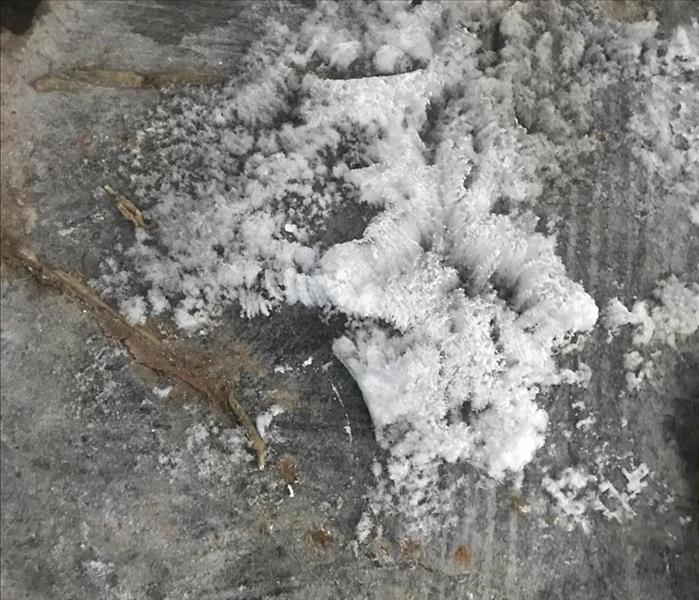 This Photo shows one of the ways Mold looks like, Its white, Fuzzy and 100% completely harmful. This mold grew underneath the hardwood floor.
This Photo shows one of the ways Mold looks like, Its white, Fuzzy and 100% completely harmful. This mold grew underneath the hardwood floor.
WHAT IS MOLD?
Mold is a microscopic, airborne fungus that decomposes organic material in the presence of moisture. The key to preventing mold is to control moisture. Many building materials are conducive to mold growth if there is a persistent source of water. Kitchens, bathrooms, and basements are especially prone to mold because there are consistent sources of moisture, including standing water, humidity, and condensation. Certain seasons and climates are also more conducive for mold growth as well.
Mold is typically blue, green, grey, and black, may look fuzzy, and usually grows in thread-like structures. Other signs of mold are persistent odors, crumbling walls, discoloration spots, and peeling paint. Cleaning mold with bleach only treats the symptom. Without resolving the source of the water, mold will return.
Cleaning the mold with a mixture of bleach and water is not enough and not a wise choice. Mold is a symptom associated with a persistent source of moisture, such as a leaky pipe, persistent condensation, or consistent humidity. The source of moisture must be fixed to prevent mold from returning.
MOLD REMEDIATION
Mold is always the symptom of some type of water issue. Without a source of moisture, mold cannot thrive. Aside from the health risks of mold, it can weaken building materials or even cause structural issues if left unresolved.
After an initial assessment, our highly trained and experienced crews will remove materials contained with mold. To prevent a recurrence, they clean, clean, deodorize, and sanitize the area.
Common Causes of Mold Growth
- Persistent Condensation
- Consistent Humidity
- Leaky Water Pipes and Plumbing Fixtures
- Flood Damage That Was Improperly Cleaned Up
- Leaking Roofs or Windows
SERVPRO of San Mateo always offers 24-hour emergency service, let our compassionate and dependable restoration specialists give you peace of mind in an emergency.
Mold Removal
12/24/2018 (Permalink)
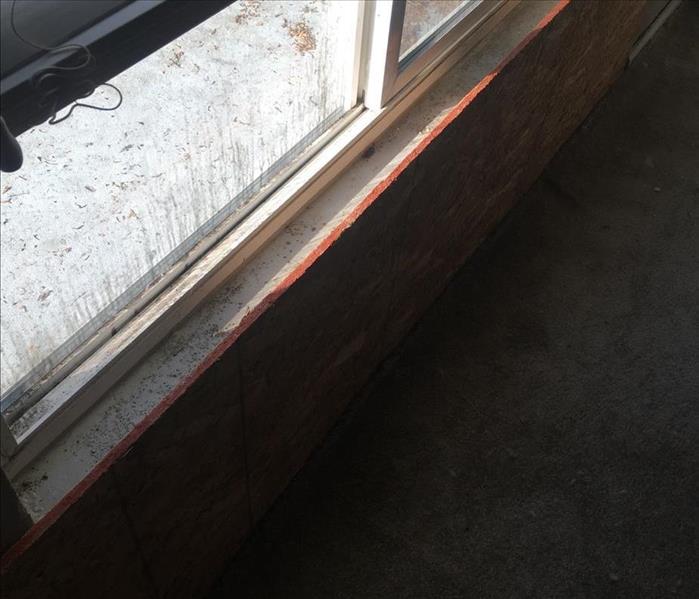 Photo shows mold had been growing, you can see that mold was covered with plywood. Please Conatct SERVPRO of San Mateo for proper mold remediation.
Photo shows mold had been growing, you can see that mold was covered with plywood. Please Conatct SERVPRO of San Mateo for proper mold remediation.
Mold Removal Services in San Mateo and Surrounding Areas
SERVPRO of San Mateo is your local expert for mold inspection, mold remediation (mold removal) contractor and water damage repair.
Molds common to San Mateo and surrounding areas are microscopic organisms found virtually everywhere, indoors and outdoors.
Mold spores are very tiny, light-weight, and easily-detached by airflow, vacuuming, walking on carpet, or sitting on a couch. In indoor environments mold spores grow in carpets, hardwoods, walls & any porous materials. They produce and release millions of spores, which are small enough to stay airborne, threatening to invade the human respiratory system.
In large quantities, Black mold and molds can cause allergic symptoms like those caused by plant pollen. Mold growths can often be seen in the form of discoloration, ranging from white to orange and from green to brown or black.
For mold to grow, it needs food sources (such as leaves, wood, paper, or dirt), a source of moisture, and a place to grow.
What is Toxic Mold?
While mold exists everywhere, it sometimes takes on a dangerous form. The scientific name for the greenish-black mold that turns up on carpet, wallpaper, ceiling tiles, and even wet leaves is Stachybotrys Chart arum or Black Mold. It produces a mycotoxin that causes mycotoxicosis and is thought to be the cause of “sick building syndrome.”
Where Can Mold Turn Up?
Mold can be found in many areas of your home: Attic, Bathrooms, Basement, Bedrooms, Kitchen, Living Room, Garage, and Carpets & Hardwoods.
What to Do If You See Mold?
Do not panic. Try to not disrupt the area where the mold is. Call SERVPRO of San Mateo immediately for mold removal and remediation in San Mateo and surrounding areas. Our highly trained professionals are equipped to remove the mold from your home in a safe and cost-effective way.
Approaching Mold and Mildew
12/12/2018 (Permalink)
When moisture remains undetected, mold occurs, causing severe damage and health concerns. It’s critical to take care of mold and mildew damage early before it overtakes your entire home, apartment complex or business.
SERVPRO of San Mateo offers comprehensive mold removal and remediation services including:
- Initial Inspection
- Development of work scope
- Containment set-up, management and tear-down
- Mold removal and discarding of total loss items
- Mold remediation and removal of contaminated building materials
- Detailed cleaning and decontamination of structures and contents
- HVAC cleaning and decontamination
- HEPA vacuuming
- Air scrubbing
- Duct cleaning
- Moisture control
- Sanding and physical removal of mold growth from the building envelope
- Installation and maintenance of HEPA equipment
- Monitoring of negative pressure contaminants
Antimicrobial Safety & Training
Maintaining a safe working environment for our crews, the facility owner, and occupants living or working in the affected area is our top priority. We are committed to performing every mold removal and remediation job by safeguarding the environment in which we are working and by using the industry's most efficient methods and equipment to protect our customers and employees. We also follow all local, state, federal, OSHA and EPA guidelines when performing mold removal and remediation procedures.
To further ensure a safe and effective environmental remediation, our crews are rigorously trained in mold removal procedures by Institute of Inspection, Cleaning and Restoration Certification (IICRC); and our in-house trainers. In addition, all our operations managers, project managers, project directors, and regional managers hold Certified Mold Remediation (CMR) certifications.
Mold Remediation
12/7/2018 (Permalink)
 Mold is very unhealthy and if it's not taken care of properly it can easily and quickly spread everywhere.
Mold is very unhealthy and if it's not taken care of properly it can easily and quickly spread everywhere.
MOLD REMEDIATION: OUR MOLD REMOVAL SERVICE
Stop Mold Growth
Mold remediation is a specialized process requiring a unique combination of training and ability. SERVPRO professional mold removal teams are considered the best in the industry. SERVPRO of San Mateo has the training and expertise to remediate the mold in your home or business.
Mold has the potential to cause health effects and can spread through your property in as little as 48 hours. SERVPRO of San Mateo understands mold and mold growth and has the training and expertise to remediate the mold in your home or business.
Our professional mold mitigation services include:
- Mold Identification
- Containment Enclosures
- Engineering Controls and PPE
- Mold Removal
- Structural Drying and Dehumidification
- HVAC Cleaning
- Decontamination
- Disposal - Contaminated Materials
Proper Structural Drying Prevents Mold Growth
Mold growth results from the failure of quick and proper drying following water intrusion. Here are some steps to alleviate on-going problems:
- Moisture levels in all affected building components should be measured to determine where the water damage has occurred.
- Hidden moisture, such as in ceiling plenums and wall cavities, must be tracked and measured.
- The right equipment for the job must be properly placed for rapid drying.
- Daily moisture readings should be recorded and reported (a critical defense in case of health allegations).
- Determine the building’s normal moisture level and document goal attainment.
Our General Estimators and trained technicians use the most up-to-date commercial dehumidification and air purifying equipment available, following all guidelines for indoor air quality.
The Mold Remediation Process
Every mold damage scenario is different and requires a unique solution, but the general mold remediation process stays the same. Learn more about our mold remediation process.
- Emergency Contact - (650) 931-6060
- Inspection and Mold Damage Assessment
- Mold Containment
- Air Filtration
- Removing Mold and Mold-Infested Materials
- Cleaning Contents and Belongings
Locally Owned Company with National Resources
SERVPRO of San Mateo is locally owned and operated—so we live and work here too and are proud to be part of this community. We are also part of a national network of over 1,700 Franchises with special Disaster Recovery Teams placed strategically throughout the country to respond to large scale disasters.
We proudly serve San Mateo, CA, and surrounding areas.
Burlingame Mold Clean Up
2/2/2018 (Permalink)
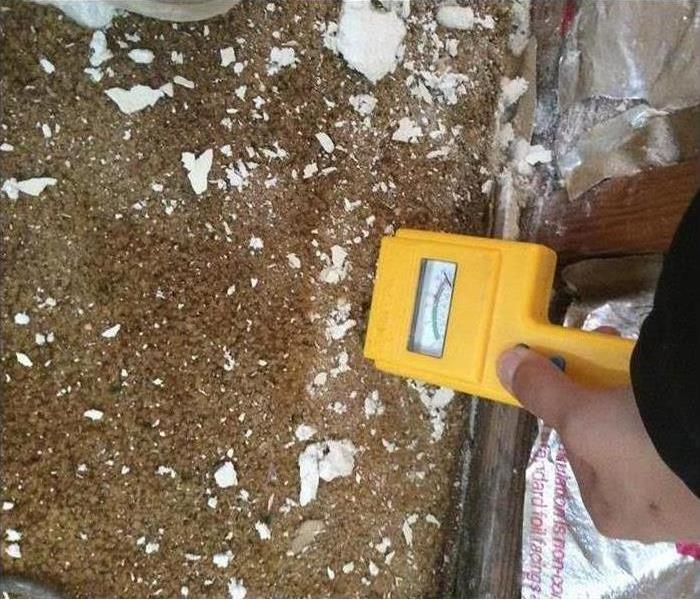 SERVPRO of San Mateo has to determine how wet the materials are before beginning the clean up and drying process.
SERVPRO of San Mateo has to determine how wet the materials are before beginning the clean up and drying process.
One does not simply remove mold, as you can see in this mold cleanup from our San Mateo franchise. We go through extensive training, certifications, and procedures established by law to remove mold from your home or business. Doing a quick sweep or squirt of bleach doesn't help, and may make things worse.
Mold cleanup in Burlingame
Mold cleanup may seem like such a drag, especially in an area that already has so much moisture in the air. However, there are ways to keep away mold long term. This technique requires professionalism, commitment, and good building materials. To get started on the process, SERVPRO can help!
The services we provide
Most people don't understand the work that's involved when dealing with mold; they just don't want to deal with it. We completely understand! From containment to removal, to cleaning and demolition, we do it all. Our project managers are also incredibly knowledgeable and work throughout San Mateo, Burlingame, Hillsborough and the surrounding areas.
Mold and Your Commercial Property's HVAC System
2/2/2018 (Permalink)
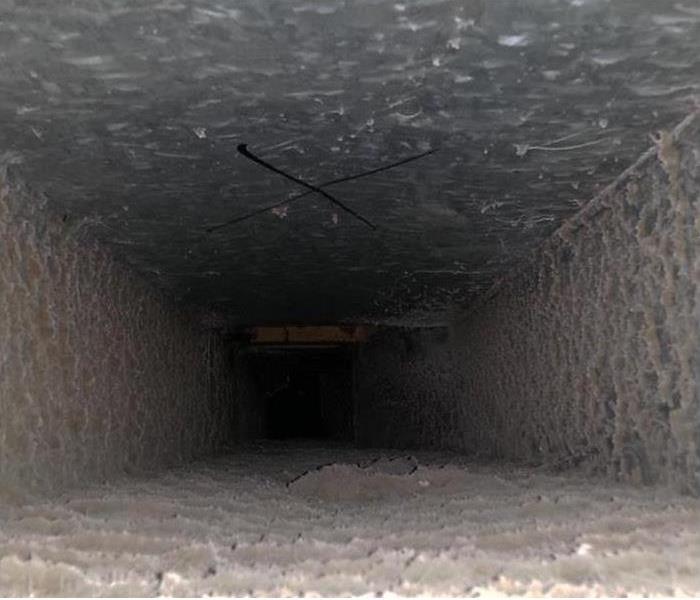 Mold Growth in HVAC System
Mold Growth in HVAC System
While mold growth in a commercial facility can be the result of a variety of factors, its HVAC system is often the culprit. With their extensive assemblage of drain pans, ducts, piping, filters and heat exchangers, these systems can provide an ideal environment for mold growth if they are not properly maintained. They also offer a convenient pathway for mold spores that can allow them to spread throughout the facility. For effective mold prevention, detection and removal, it is vital that facility managers have a good understanding of mold and how it interacts with an HVAC system.
UNDERSTANDING MOLD
Mold is always present; it is considered a problem when growth is visible on interior surfaces, reaches excessive levels or features species different from those present in outside air. To flourish, mold requires an acceptable temperature, a food source and sufficient moisture. Unfortunately, the temperatures that people prefer to maintain indoors are conducive to mold growth. Food sources like wood, paper, cardboard, fabric, carpeting, furnishings and drywall are also readily available in most buildings. This means that controlling or eliminating moisture is the best strategy for preventing mold growth.
ASSESSING YOUR HVAC SYSTEM FOR MOLD
Issues with the design, installation or maintenance of its HVAC system can leave a commercial facility vulnerable to mold. When assessing the HVAC system for mold, there are several key components that should be inspected, including:
Drain pans and coils. Cooling cools pull humidity from the air. The resulting condensate water should drip into a drain pan and exit the system via a deep seal trap, but improper design or maintenance of the drain pain can result in standing water, an ideal microbial habitat. Proper sloping and regular cleaning of the drain pan allow it to function appropriately.
Dehumidification equipment. The wet surfaces found here can supply the moisture necessary for mold growth. Periodically treating them to prevent microbial growth is crucial, but care must be taken to avoid dampening duct linings.
Cooling towers. Water quality monitoring and periodic chemical treatment can help prevent microbial growth. If sediment accumulation is an issue, physical cleaning may also be required.
Outdoor air dampers. Debris on screens and grills can build up, blocking them and providing a harbor for mold growth. Regular cleaning can head off potential problems.
Ducts. While some dust is to be expected, areas that are subject to restricted airflow or moisture are susceptible to contamination. Spaces with duct lining can also be more vulnerable. To avert trouble, maintain filters, coils and drip pans, protect key system components from moisture accumulation, and repair any water damage promptly. It also helps to minimize the buildup of dust and debris by performing the appropriate housekeeping, especially during any renovation or construction.
Air filters. To prevent contaminants from entering the system, filters should fit properly and match the expected airflows. They need to be changed regularly, and fans should be shut off during the process to avoid contamination.
Air intakes. Groupings of organic material in or near HVAC intakes should raise a red flag. Droppings from birds or bats and debris from areas near garbage cans, standing rain water, drainage ponds, vegetation or freshly disturbed earth can result in elevated levels of airborne fungal spores. Return-air plenum. The space above ceiling tiles is often employed as a return-air plenum, so it is important to follow the code that restricts material in the plenum to avoid contamination and ensure uninterrupted airflow.
DEALING WITH MOLD
The interior structures of commercial HVAC systems offer numerous reservoirs where moisture can linger, creating a perfect environment for mold, and remediation can be incredibly challenging. If mold cleanup is required, it is critical that it be completed by trained workers who have the right tools for the job because the proper use of isolation procedures, decontamination methods and personal protective equipment is crucial. If done incorrectly, attempts at mold removal can damage components of the HVAC system and may actually spread the mold spores to new areas. Many facility managers prefer to rely on professional mold remediation services.
SERVPRO’S PROFESSIONAL MOLD REMEDIATION SERVICES
If you suspect that your HVAC system or any other part of your commercial property has been contaminated by mold, turn to the professionals at SERVPRO. Our experienced technicians are fully certified, so you can be confident that they have the knowledge and expertise needed to tackle even the toughest mold problems. When you contact us for mold remediation services, we will:
• Respond promptly. • Perform an expert assessment to pinpoint the locations of visible and hidden mold. • Use advanced containment methods to isolate areas with active fungal growth and prevent the spread of the mold. • Remove microscopic mold spores from the air with specialized filtration equipment. • Apply anti-fungal treatments to eliminate mold growth and properly dispose of any mold-infested materials that cannot be salvaged. • Employ a variety of techniques to clean and sanitize any affected items and deodorize the area. • Provide restoration services that return the area to its preloss condition.
At SERVPRO, we take pride in being your best resource for mold remediation. If water or fire has damaged your property, our commercial restoration services can get you back in business fast. With more than 40 years in the industry, an award-winning training program, a variety of specialized cleaning services, we are ready to tackle your most challenging jobs. Offering 24/7 emergency services, we are there whenever you need us, and you can always count on our professional team to leave your commercial property looking its best. Call us today to explore our full range of services or request our assistance.
Advice to Prevent Mold Infestation
2/2/2018 (Permalink)
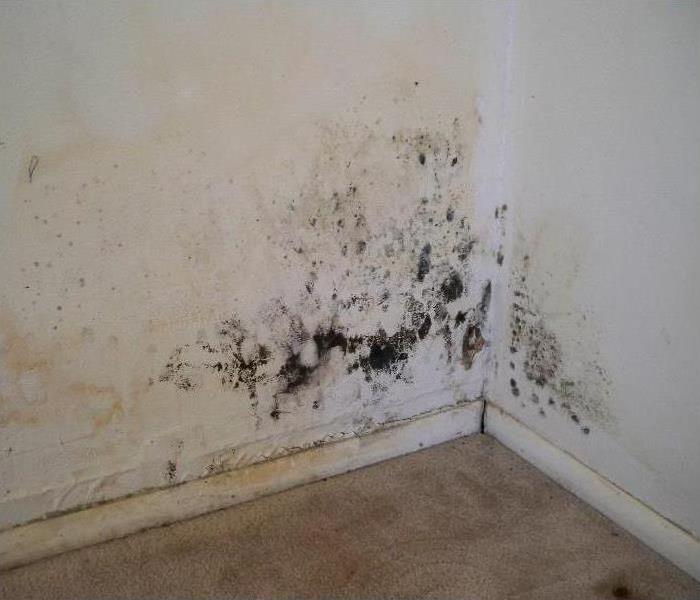 Mold Growth in San Francisco
Mold Growth in San Francisco
Advice to Prevent Mold Infestation
Mold damage, unlike water and fire damage, can often be prevented in a home if the proper precautions are taken. Although a few things in your home such as temperature and humidity can't be efficiently controlled so that mold will be discouraged to grow and you won't be uncomfortable, the most important factor in mold growth - water - can be monitored. Additionally, other methods such as improving ventilation and airflow are entirely possible for the average homeowner, and preventing future mold growth might be easier than you think.
Seal Out Water
Controlling the flow of water into your home is essential in keeping out mold damage in San Mateo. Sealing cracks, making sure windows close correctly and re-tiling roofs once they begin to outlive their average lifespan are all important factors in keeping your home's interior dry and mold out of your hair. These aren't typically expensive renovations, requiring sealant and mold-retardant paint, and you can always hire SERVPRO technicians to ensure that the materials are applied correctly. It's a small price to pay to ensure that mold stays out of your home.
Try and Improve Airflow
If possible, make efforts to improve airflow in your home. Stuffy, stagnant rooms are suitable for mold growth, so opening windows and allowing airflow will always help to protect against mold. Be mindful, however, that you don't leave windows open permanently. If rainwater comes in through those openings, it can cause mold damage and a heap of other problems for you as well. A SERVPRO San Mateo representative may be able to meet with you to help to discuss ways to improve airflow and ventilation in your home, safely.
Clean Regularly
Whether you prefer to clean yourself or hire a service, ensuring that the whole of your home is regularly and thoroughly cleaned is a critical step in ferreting out mold early on and preventing it from finding a suitable surface. Regular cleaning deprives mold of a food source, helps to wipe away moisture, and most importantly gets someone looking at dark corners.
Locally Owned Company with National Resources
If mold does end up getting into your home, SERVPRO of San Mateo is trained and equipped to help deal with it with as little time and money spent as possible. Call us 24/7 at (650) 931-6060 for our services or a quote.
Professional Mold Remediation For Your Home
2/2/2018 (Permalink)
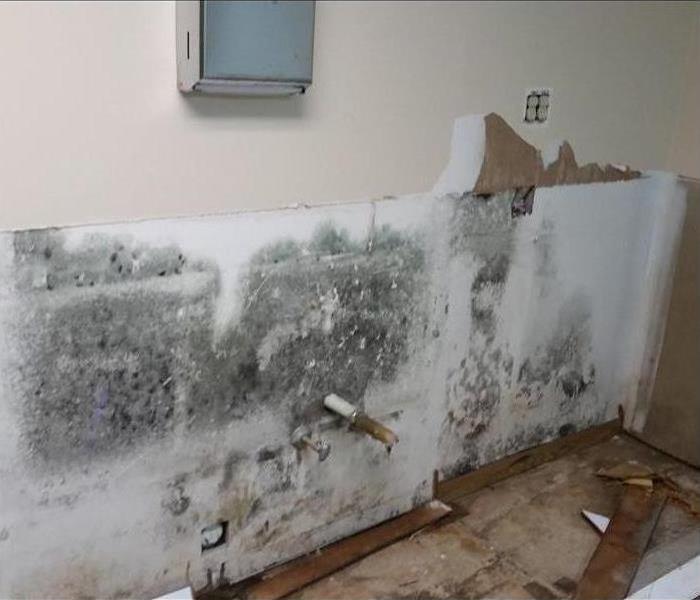 Mold Damage found Inside Walls in Burlingame, San Mateo County
Mold Damage found Inside Walls in Burlingame, San Mateo County
Believe it or not, mold can occasionally be a good thing. After all, some species of mold are used in the production of antibiotics, foods, and beverages. Unfortunately, the kinds of mold that commonly flourish in homes and businesses are not helpful. These molds range from annoying irritants to dangerous health hazards. Difficult to eradicate and capable of causing real damage, these molds require careful remediation. The proper technique and equipment are vital, so it is a job best left to professionals like the experts at SERVPRO of San Mateo.
What Is Mold?
Molds are microscopic fungi that spread through spores. Mold spores are everywhere, and they are quick to latch onto any organic material in humid environments. They do not need sunlight to survive, but moisture is vital. If the conditions are right, mold can grow quickly, forming large colonies. It can inhabit nearly any organic material, including food, paper or wood products. Mold might resemble moss in appearance, but it is not a form of plant life, and it does not use photosynthesis to feed itself. Instead, it releases enzymes that break down the organic material hosting it, damaging the material so that it can get the nutrients it needs by absorbing the degraded remains. Many homeowners discover mold when they smell its musty, earthy odor.
Is Mold That Dangerous?
Mold is ugly, annoying and truly dangerous. Mycotoxins, liquids or gasses produced by active mold colonies, are incredibly toxic. Ingestion of mycotoxins can cause health problems, and just touching these hazardous chemicals can cause health hazards. Mold is very a nasty neighbor, so you want to take steps to prevent it from moving into your space.
How can you prevent a mold infestation?
Mold spores may be everywhere, but without moisture, they cannot grow into a problem, so controlling moisture and humidity is the best way to prevent a mold infestation. Try to keep indoor humidity below 45 percent. If a plumbing problem, leak or flood introduces moisture, a fast fix is crucial. Your best hope for preventing mold is to stop the inflow of moisture by repairing the problem and quickly eliminating the dampness. Time is of the essence, so if there is a delay in locating or repairing the problem, it may be too late to keep mold at bay. If you suspect that mold has gotten a toehold in your home or business, do not wait. A mold infestation spreads rapidly, so you want to act fast to get rid of it.
What’s Wrong With DIY Mold Removal?
Although it can be tempting to try and clean up mold yourself, smart homeowners call in the professionals immediately. Improper cleaning techniques can spread the mold spores, making the problem bigger than ever. Worse, if the individuals doing the work fail to protect themselves adequately from the mold and the mycotoxins it produces, health hazards are a likely consequence. Prompt, professional mold remediation services can protect your family’s health, stop the mold from spreading further in your home and potentially save you money by preventing additional damage.
What Should I Expect During Professional Mold Remediation?
SERVPRO of San Mateo has the highly trained personnel and professional equipment necessary to tackle mold remediation. When you call us, our team completes a thorough inspection of your property and identify the areas of concern. Certified by the Institute of Inspection Cleaning and Restoration Certification (IICRC), our skilled experts can detect both visible and hidden mold. We also have equipment that allows us to trace the water source that is feeding the mold. After locating the mold, we set up a negative air pressure chamber to isolate the area and prevent the spread of spores that might be stirred up during the remediation process, protecting your family and your home. We also utilize air scrubbers and special HEPA vacuums to corral the mold and eliminate it.
At SERVPRO of San Mateo, we use antimicrobial and antifungal treatments to destroy existing mold colonies and prevent new ones. Depending on the amount of mold growth and the surfaces involved, it may be necessary to remove porous materials like carpet, paneling or drywall. If your situation requires it, we can handle it, disposing of the materials safely to avoid contaminating other spaces in your home. Of course, not every item exposed to mold is a lost cause. Our technicians have the expertise to restore many types of belongings and can clean and sanitize things like household items, curtains, furniture, clothing and other decor. We can also deodorize the space to remove the mold’s pungent, musky odor.
If you are concerned that you may have a mold issue on your property, do not hesitate. SERVPRO San Mateo is there for you around the clock. Call us today to learn more about our mold remediation services and request our help. (650) 931-6060
Does Your San Mateo Home Have A Mold Problem?
2/2/2018 (Permalink)
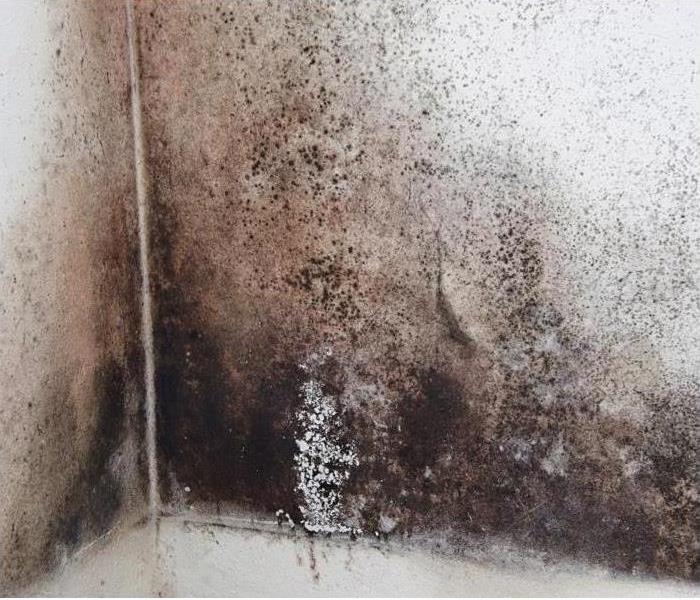 In San Mateo, Burlingame, Hillsborough, or San Francisco, mold can spread through a home in as little as 48 hours.
In San Mateo, Burlingame, Hillsborough, or San Francisco, mold can spread through a home in as little as 48 hours.
Microscopic mold spores naturally occur almost everywhere, both outdoors and indoors. This makes it impossible to remove all mold from a home or business. Therefore, mold remediation reduces the mold spore count back to its natural or baseline level. Some restoration businesses advertise “mold removal” and even guarantee to remove all mold, which is a fallacy. Consider the following mold facts:
- Mold is present almost everywhere, indoors and outdoors.
- Mold spores are microscopic and float along in the air and may enter your home through windows, doors, or AC/heating systems or even hitch a ride indoors on your clothing or a pet.
- Mold spores thrive on moisture. Mold spores can quickly grow into colonies when exposed to water. These colonies may produce allergens and irritants.
- Before mold remediation can begin, any sources of water or moisture must be addressed. Otherwise, the mold may return.
- Mold often produces a strong, musty odor and can lead you to possible mold problem areas.
- Even higher-than-normal indoor humidity can support mold growth. Keep indoor humidity below 45 percent.
If your home or business has a mold problem, we can inspect and assess your property and use our specialized training, equipment, and expertise to remediate your mold infestation.
If You See Signs of Mold, Call Us Today at 650-931-6060
San Mateo Residents: Follow These Mold Safety Tips If You Suspect Mold
2/2/2018 (Permalink)
 Be careful! Without proper training, you could be spreading mold throughout your home in San Francisco, San Mateo, Burlingame, or Hillsborough.
Be careful! Without proper training, you could be spreading mold throughout your home in San Francisco, San Mateo, Burlingame, or Hillsborough.
If you see visible mold, do not disturb it. You can inadvertently spread the mold infestation throughout your home. When mold is disturbed, the mold can release microscopic mold spores which become airborne and can circulate inside your home.
What to Do:
- Stay out of affected areas.
- Turn off the HVAC system and fans.
- Contact SERVPRO of San Mateo for mold remediation services.
What Not to Do:
- Don’t touch or disturb the mold.
- Don’t blow air across any surfaces with visible or suspected mold growth.
- Don’t attempt to dry the area yourself.
- Don’t spray bleach or other disinfectants on the mold.
About Our Mold Remediation Services
SERVPRO of San Mateo specializes in mold cleanup and restoration, in fact, it’s a cornerstone of our business. Our crews are highly trained restoration professionals that use specialized equipment and techniques to properly remediate your mold problem quickly and safely.
If You See Signs of Mold, Call Us Today. 650-931-6060
Modifications to Industry Standard for Mold Removal by Robert Lay
2/2/2018 (Permalink)
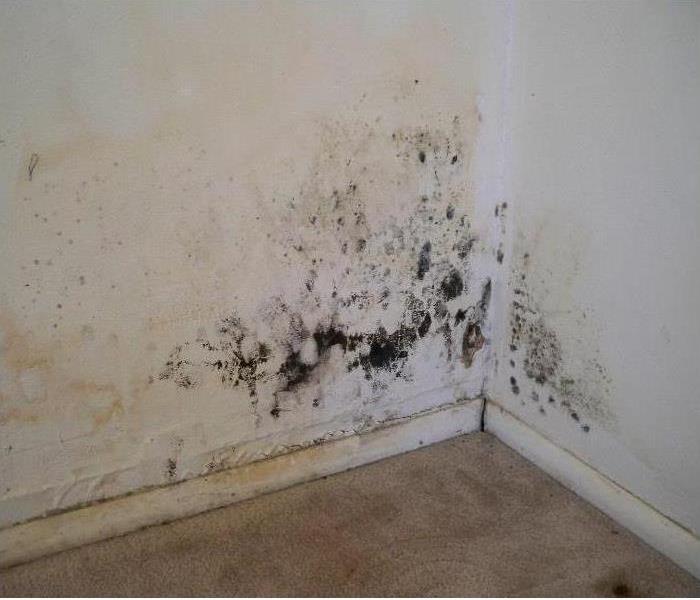 Mold Damage and Mold Spores can spread throughout your Bay Area home quickly if not treated
Mold Damage and Mold Spores can spread throughout your Bay Area home quickly if not treated
After years of scare tactics presented by national media outlets, the IICRC pulled the reigns back on fly - by - night restoration companies that claimed to disinfect or remove mold through encapsulation, ozone, or other decontaminants. In doing so, the S-520 was created to help provide a national standard that centered mostly around "source removal" of affected material, as we well as proper standards for creating containment, establishing negative air pressure, and properly removing mold. This document contains a wealth of knowledge pertaining to the health effects of mold exposure and provides usable advice to mold remediators in keeping employees safe. As the restoration industry is a constantly evolving industry, the standard is often considered a 'living' document. Like most industries, change is driven by technological advancements.
What You Should Know About Mold
Mold is a naturally occurring organism and certain levels are considered acceptable in both indoor and outdoor levels. These levels are often referred to as Condition 1 type mold. When physical growth is achieved (Condition 3) on building materials, it has the propensity to produce a Condition 2 type situation where spores and hyphae settle on surfaces. Actual growth includes growth of any type of mold (active, dormant, visible or hidden). Not all mold is harmful, but certain types can cause health effects to immune deficient or allergenic prone individuals.
What Has Changed in the Latest Version
Verbage has been the biggest alteration in the newest version of the S520. Better definitions of trigger words are provided to help remediation specialists better interpret guidelines of the standard of care. Misting is more widely accepted for dust suppression. Rules for better servicing sensitive environment facilities like retirement homes and hospitals have been outlined to include real time data logging system. This decreases risk of cross contamination and helps ensure that Air Filtration Devices and Negative Air Machines are operating properly. Mold contamination of Air Conditioning Systems is also better outlined. Use of EPA approved sealants or coatings are more widely observed. Lastly, contractors may now perform Post Remediation Evaluation, but a 3rd party Industrial Hygienist will still be needed to perform Post Remediation Verification.
How Does This Help Protect You and Your Home or Business
Dampness or visible fungi can be found in 50% of residences across the country (Mudarri and Fisk, 2007). At current there are no accepted guidelines defining normal fungal ecology. Comparative or control samples are needed to assess what can be dictated as "safe" however this does not incorporate certain variables like geography, occupancy, land use, time of year, and time of day. The IICRC S-520 -2015 helps bridge the gap in using technological advances and definitive verbage to reiterate proper remediation efforts are used and quantified in your home or business. Indoor air quality is directly related to personal health and indoor health professionals are constantly being held to a higher standard as more information becomes available.
Mudarri, D. and Fiskm W.J. (2007) "Public health and economic impact of dampness and mold." Indoor Air 17, 226-235
Advice for Mold Infestation
11/8/2017 (Permalink)
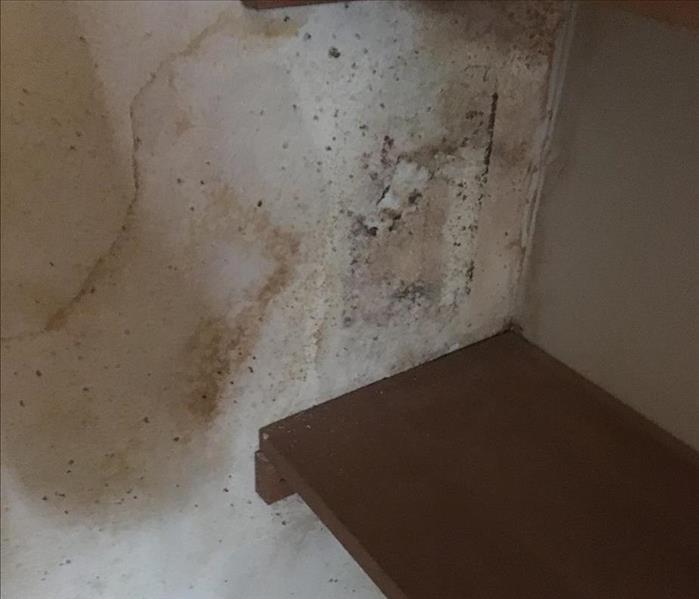 In this Residential home mold was appearing in various areas of the Home.
In this Residential home mold was appearing in various areas of the Home.
Advice to Prevent Mold Infestation
Mold damage, unlike water and fire damage, can often be prevented in a home if the proper precautions are taken. Although a few things in your home such as temperature and humidity can't be efficiently controlled so that mold will be discouraged to grow and you won't be uncomfortable, the most important factor in mold growth - water - can be monitored. Additionally, other methods such as improving ventilation and airflow are entirely possible for the average homeowner, and preventing future mold growth might be easier than you think.
Understanding Mold
Microscopic mold spores exist almost everywhere, outdoors and indoors, making it impossible to remove all mold from a home or business. Some restoration businesses advertise “mold removal” and even guarantee to remove all mold, which is a fallacy. Consider the following mold facts:
- Mold is present almost everywhere, indoors and outdoors.
- Mold spores are microscopic and float along in the air and may enter your home through windows, doors, or AC/heating systems or even hitch a ride indoors on your clothing or a pet.
- Mold spores thrive on moisture. Mold spores can quickly grow into colonies when exposed to water. These colonies may produce allergens and irritants.
- Before mold remediation can begin, any sources of water or moisture must be addressed. Otherwise, the mold may return.
- Mold often produces a strong, musty odor and can lead you to possible mold problem areas.
- Even higher-than-normal indoor humidity can support mold growth. Keep indoor humidity below 45 percent.
Seal Out Water
Controlling the flow of water into your home is essential in keeping out mold damage in San Mateo. Sealing cracks, making sure windows close correctly and re-tiling roofs once they begin to outlive their average lifespan are all important factors in keeping your home's interior dry and mold out of your hair. These aren't typically expensive renovations, requiring sealant and mold-retardant paint, and you can always hire SERVPRO technicians to ensure that the materials are applied correctly. It's a small price to pay to ensure that mold stays out of your home.
Try and Improve Airflow
If possible, make efforts to improve airflow in your home. Stuffy, stagnant rooms are suitable for mold growth, so opening windows and allowing airflow will always help to protect against mold. Be mindful, however, that you don't leave windows open permanently. If rainwater comes in through those openings, it can cause mold damage and a heap of other problems for you as well. A SERVPRO San Mateo representative may be able to meet with you to help to discuss ways to improve airflow and ventilation in your home, safely.
Clean Regularly
Whether you prefer to clean yourself or hire a service, ensuring that the whole of your home is regularly and thoroughly cleaned is a critical step in ferreting out mold early on and preventing it from finding a suitable surface. Regular cleaning deprives mold of a food source, helps to wipe away moisture, and most importantly gets someone looking at dark corners.
Locally Owned Company with National Resources
If mold does end up getting into your home, SERVPRO of San Mateo is trained and equipped to help deal with it with as little time and money spent as possible. Call us 24/7 at (650) 931-6060 for our services or a quote.
Modifications to Industry Standard for mold removal
10/19/2017 (Permalink)
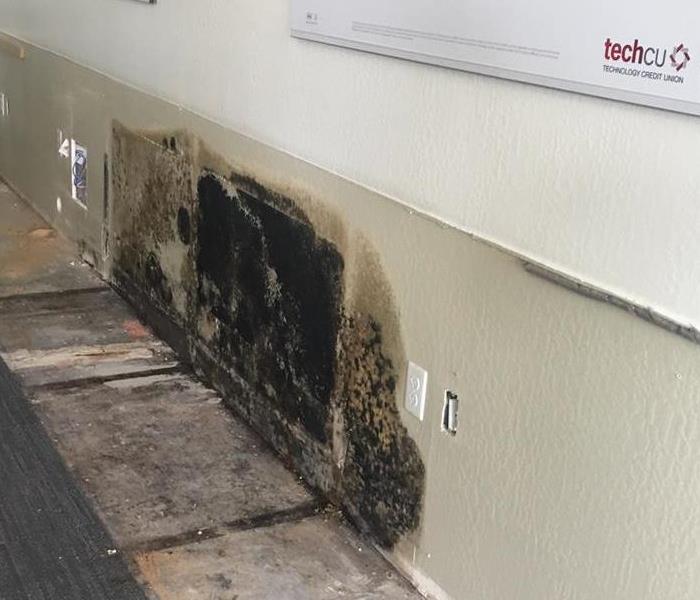 This water damage was a result of mold, Property owners did not call to take care of this water damage immediately.
This water damage was a result of mold, Property owners did not call to take care of this water damage immediately.
After years of scare tactics presented by national media outlets, the IICRC pulled the reigns back on fly - by - night restoration companies that claimed to disinfect or remove mold through encapsulation, ozone, or other decontaminates. In doing so, the S-520 was created to help provide a national standard that centered mostly around "source removal" of affected material, as we well as proper standards for creating containment, establishing negative air pressure, and properly removing mold. This document contains a wealth of knowledge pertaining to the health effects of mold exposure. As the restoration industry is a constantly evolving industry, the standard is often considered a 'living' document. Like most industries, change is driven by technological advancements.
What You Should Know About Mold
Mold is a naturally occurring organism and certain levels are considered acceptable in both indoor and outdoor levels. These levels are often referred to as Condition 1 type mold. When physical growth is achieved (Condition 3) on building materials, it has the propensity to produce a Condition 2 type situation where spores and hyphae settle on surfaces. Actual growth includes growth of any type of mold (active, dormant, visible or hidden). Not all mold is harmful, but certain types can cause health effects to immune deficient or allergenic prone individuals.
Confusion and misunderstanding surround the topic of mold and mold remediation. Some restoration businesses even make claims to remove all mold from a building. This is a fallacy. Mold spores occur naturally almost everywhere, both indoors and outdoors. These microscopic spores float along in the air and can enter a home or business through windows and HVAC systems. Consider these facts:
- Mold is present almost everywhere, indoors and outdoors.
- Mold spores are microscopic and float along in the air and may enter your home through windows, doors, or AC/heating systems or even hitch a ride indoors on your clothing or a pet.
- Mold spores thrive on moisture. Mold spores can quickly grow into colonies when exposed to water. These colonies may produce allergens and irritants.
- Before mold remediation can begin, any sources of water or moisture must be addressed. Otherwise, the mold may return.
- Mold often produces a strong, musty odor and can lead you to possible mold problem areas.
- Even higher-than-normal indoor humidity can support mold growth. Keep indoor humidity below 45 percent.
What Has Changed in the Latest Version?
Verbiage has been the biggest alteration in the newest version of the S520. Better definitions of trigger words are provided to help remediation specialists better interpret guidelines of the standard of care. Misting is more widely accepted for dust suppression. Rules for better servicing sensitive environment facilities like retirement homes and hospitals have been outlined to include real time data logging system. This decreases risk of cross contamination and helps ensure that Air Filtration Devices and Negative Air Machines are operating properly. Mold contamination of Air Conditioning Systems is also better outlined. Use of EPA approved sealants or coatings are more widely observed. Lastly, contractors may now perform Post Remediation Evaluation, but a 3rd party Industrial Hygienist will still be needed to perform Post Remediation Verification.
How Does This Help Protect You and Your Home or Business
Dampness or visible fungi can be found in 50% of residences across the country. At current there are no accepted guidelines defining normal fungal ecology. Comparative or control samples are needed to assess what can be dictated as "safe" however this does not incorporate certain variables like geography, occupancy, land use, time of year, and time of day. The IICRC S-520 -2015 helps bridge the gap in using technological advances and definitive verbiage to reiterate proper remediation efforts are used and quantified in your home or business. Indoor air quality is directly related to personal health and indoor health professionals are constantly being held to a higher standard as more information becomes available.
Do You Have A Mold Problem?
10/19/2017 (Permalink)
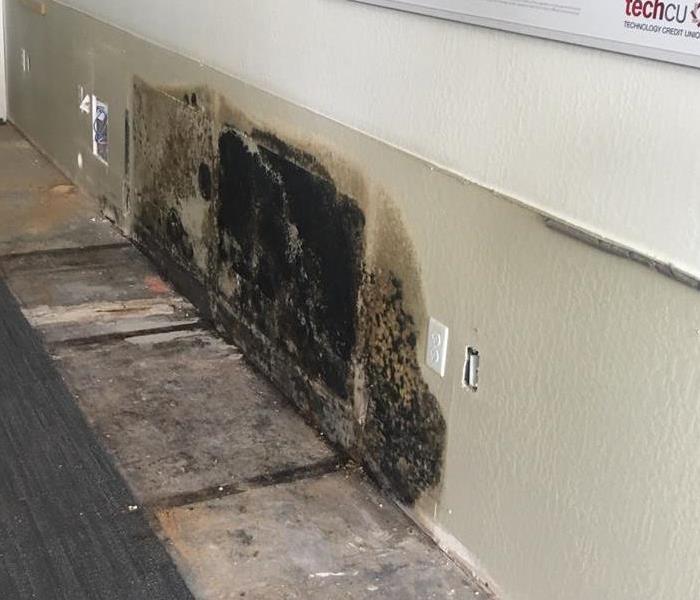 In San Francisco Mold was spread in less then 24 hours
In San Francisco Mold was spread in less then 24 hours
Microscopic mold spores naturally occur almost everywhere, both outdoors and indoors. This makes it impossible to remove all mold from a home or business. Therefore, mold remediation reduces the mold spore count back to its natural or baseline level. Some restoration businesses advertise mold removal and even guarantee to remove all mold, which is a fallacy. Consider the following mold facts:
- Mold is present almost everywhere, indoors and outdoors.
- Mold spores are microscopic and float along in the air and may enter your home through windows, doors, or AC/heating systems or even hitch a ride indoors on your clothing or a pet.
- Mold spores thrive on moisture. Mold spores can quickly grow into colonies when exposed to water. A These colonies may produce allergens and irritants.
- Before mold remediation can begin, any sources of water or moisture must be addressed. Otherwise, the mold may return.
- Mold often produces a strong, musty odor and can lead you to possible mold problem areas.
- Even higher-than-normal indoor humidity can support mold growth. Keep indoor humidity below 45 percent.
If your home or business has a mold problem, we can inspect and assess your property and use our specialized training, equipment, and expertise to remediate your mold infestation.
If You See Signs of Mold, Call Us Today at 650-931-6060

 24/7 Emergency Service
24/7 Emergency Service
